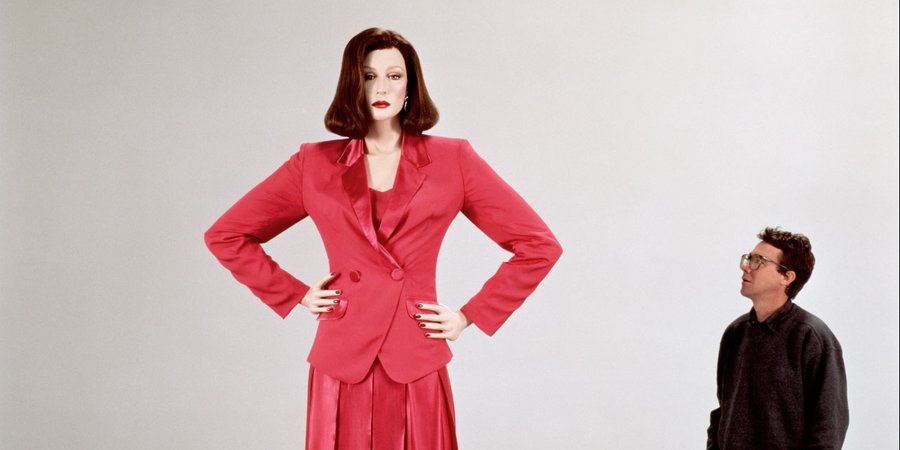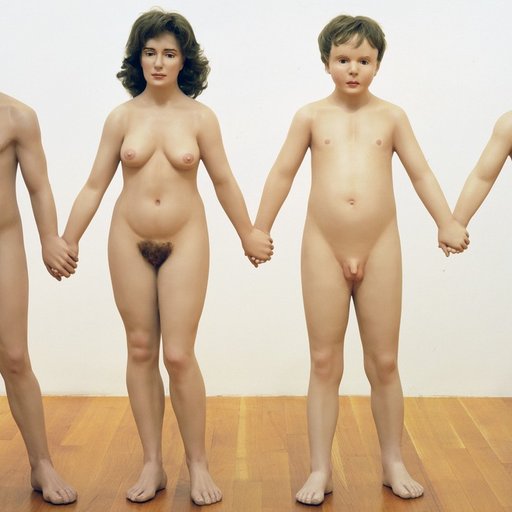Currently the subject of a retrospective at the Art Institute of Chicago covering work made between 1997 and 2014, the American artist Charles Ray makes large and obsessively detailed works that draw from classical sculpture and contemporary conceptualism in roughly equal proportions. The work discussed here, Fall ’91, was actually completed in 1992 and is thus excluded from the Institute’s exhibition, but this essay by the New Museum curator Massimiliano Gioni’s essay (excerpted in its entirety from Phaidon’s 2011 bookDefining Contemporary Art) nevertheless touches upon the uncanny realism central to Ray’s work throughout his career—so much so, in fact, that Gioni included it in his 2013 Venice Biennale.
Wearing an electric-blue power suit whose padded shoulders underscore the rather cheap look of this department-store mannequin, Fall ’91 towers over viewers from a height of nearly 250 centimeters. To build it, Charles Ray followed the standards used by Sears department stores—which he analyzed with the same maniacal care he devotes to every project—but increased the proportions of the original model by one third. The resultant distortion might at first escape notice, especially from a distance. (A brunette version of the work was installed at the end of a long hallway when presented for the first time in the now-legendary 1992 group show “Helter Skelter” at the Museum of Contemporary Art in Los Angeles.) Up close, on the other hand, the shift in scale is obvious and turns every viewer into the contemporary version of a donor in a medieval painting; standing next to this sculpture, we feel shrunken into tiny extras in a tableau of superhuman dimensions. Then again, this effect is a hallmark of all work by Ray, who has a flair for travelling through art history, revealing unexpected links and transferring solemn poses and lofty stylistic elements into the most ordinary materials.
Giacometti’s elongated sculptures, 1970s American hyperrealism and the uncanny mannequins of the Surrealists are just a few of the varied references that come to mind in front of Fall ’91. But Ray’s sculpture offers an experience even more physical than it is intellectual. First and foremost, Fall ’91 works on our perception of and relationship to space, confronting us with an object whose mass and scale force us to perceive our bodies differently. This insistence on the phenomenological dimension of sculpture is a key characteristic in the career of the artist, who for most of the 1970s and 1980s—before coming to figurative sculpture, of which Fall ’91 is a prime example—focused on creating objects that look like something out of a science lab: kinetic sculptures, or vessels containing liquids, such as ink or Pepto-Bismol, with a mysterious viscosity. These earlier sculptures seem primarily concerned with verifying the status of their existence in the world, and our own, while Fall ’91 and the works that have followed combine this perceptual investigation with a profound reflection on the ways we represent ourselves to ourselves.
Building on the ideas of Anthony Caro and David Smith, Ray’s early experiments focused on combining different materials and forms, such as bricks and chrome-plated surfaces, or reinforcing steel and fiberglass. It is this drive to work with a wide range of materials that also yielded the first experiments in which he explored the relationship between the human body and minimalist forms, including a series of objects activated by performances. In works such as Plank Piece I and II (1973), the artist pinned his body to the wall with industrial materials, or wedged himself inside geometric structures that evoked the cubic forms of Minimalism. And this, in part, is what led to Fall ’91. After all, the polished surfaces of the mannequin resemble the finish-fetish of a certain brand of minimalist sculpture, while its clothing and pose evoke both classical sculpture—with its measured contrapposto—and its popular derivatives, which at this point have become kitsch.
The mannequin lifts its right hand in a gesture that at first could appear perfectly normal, but which here is pervaded by a strange solemnity. It doesn’t even seem like an exaggeration to compare this contemporary matron to a Byzantine empress or, better yet, to a character in a fresco by Piero della Francesca. Her face has the same diaphanous glow; the light seems to emanate from the sculpture rather than be absorbed by it, a quality Ray would explore in the decade that followed with a series of white aluminum pieces in which the otherworldly, almost ghostly quality of Fall ’91 became even more accentuated. The overall result is both prosaic and supernatural—human and all too human.























